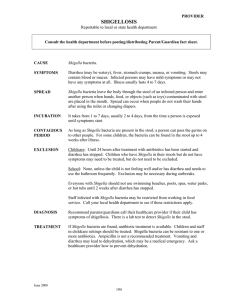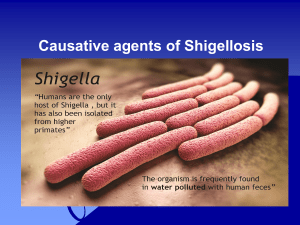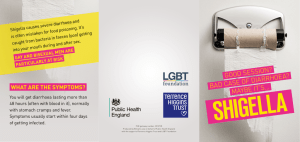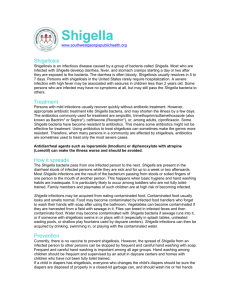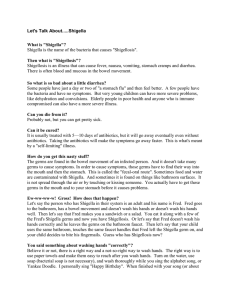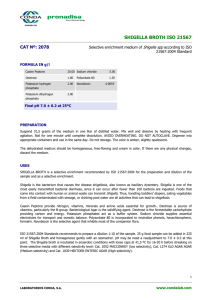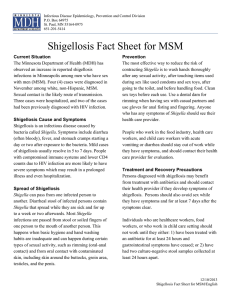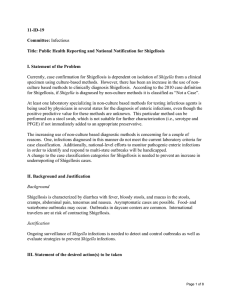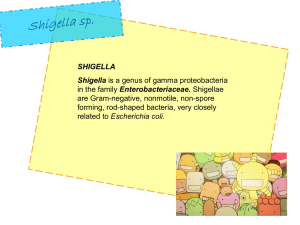shigella
advertisement
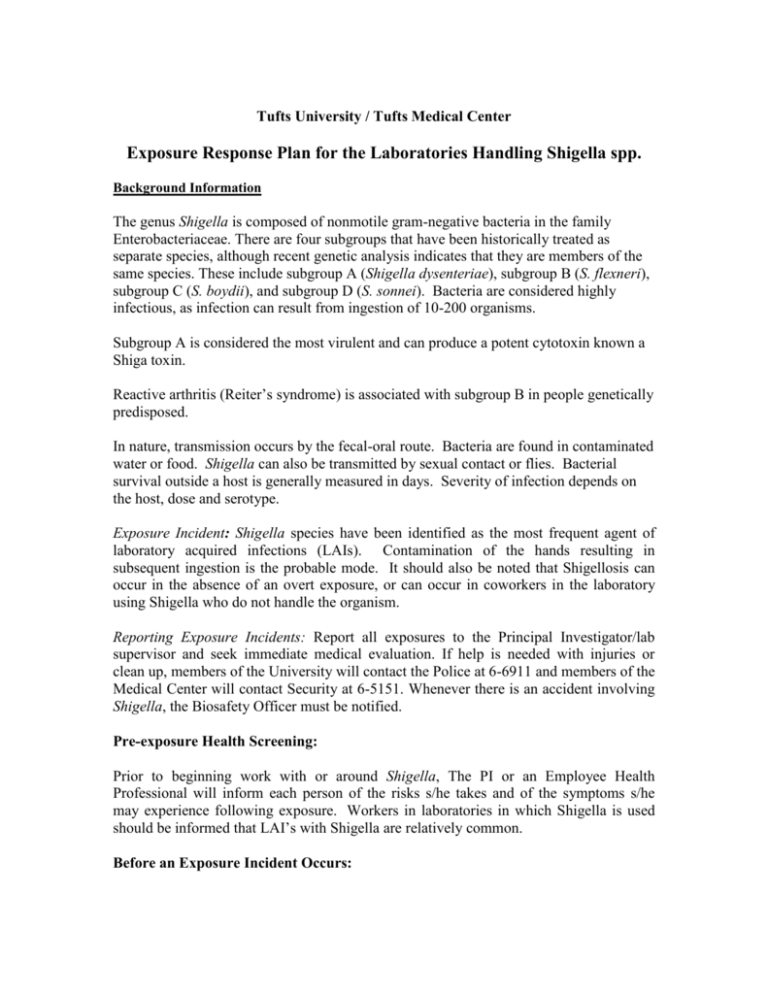
Tufts University / Tufts Medical Center Exposure Response Plan for the Laboratories Handling Shigella spp. Background Information The genus Shigella is composed of nonmotile gram-negative bacteria in the family Enterobacteriaceae. There are four subgroups that have been historically treated as separate species, although recent genetic analysis indicates that they are members of the same species. These include subgroup A (Shigella dysenteriae), subgroup B (S. flexneri), subgroup C (S. boydii), and subgroup D (S. sonnei). Bacteria are considered highly infectious, as infection can result from ingestion of 10-200 organisms. Subgroup A is considered the most virulent and can produce a potent cytotoxin known a Shiga toxin. Reactive arthritis (Reiter’s syndrome) is associated with subgroup B in people genetically predisposed. In nature, transmission occurs by the fecal-oral route. Bacteria are found in contaminated water or food. Shigella can also be transmitted by sexual contact or flies. Bacterial survival outside a host is generally measured in days. Severity of infection depends on the host, dose and serotype. Exposure Incident: Shigella species have been identified as the most frequent agent of laboratory acquired infections (LAIs). Contamination of the hands resulting in subsequent ingestion is the probable mode. It should also be noted that Shigellosis can occur in the absence of an overt exposure, or can occur in coworkers in the laboratory using Shigella who do not handle the organism. Reporting Exposure Incidents: Report all exposures to the Principal Investigator/lab supervisor and seek immediate medical evaluation. If help is needed with injuries or clean up, members of the University will contact the Police at 6-6911 and members of the Medical Center will contact Security at 6-5151. Whenever there is an accident involving Shigella, the Biosafety Officer must be notified. Pre-exposure Health Screening: Prior to beginning work with or around Shigella, The PI or an Employee Health Professional will inform each person of the risks s/he takes and of the symptoms s/he may experience following exposure. Workers in laboratories in which Shigella is used should be informed that LAI’s with Shigella are relatively common. Before an Exposure Incident Occurs: Immunization for Shigella is not available. Candidate shigellosis vaccines currently in advanced development include both polysaccharide conjugate and live attenuated vaccines and mostly focus on the most frequently isolated S flexneri 2a and S sonnei, After an Exposure Incident Occurs: Immediate Action by Route of Exposure Needlestick, Animal Bite or Laceration: Wash the area with soap and running water. Mucous membranes (eye, nose, mouth): If contaminated material is splashed or sprayed contaminating the eyes, nose or mouth: Flush the eyes for 10-15 minutes. Rinse mouth out with clean water and do not swallow. Inhalation: If contaminated materials are aerosolized outside of primary containment and potentially inhaled, rinse mouth twice expelling the rinsate. Do not swallow. Contact with intact skin and clothing: Remove contaminated clothing using gloves and place in plastic bags. Wash contaminated skin with soap and water. After an exposure incident occurs: medical evaluation and follow-up: Following immediate post exposure actions, contact the TMC Employee Health Clinic (Boston), TCSVM Occupational Medical Clinic (Grafton) or the Mt. Auburn Occupational Health Services (Medford) and arrange for medical evaluation, diagnosis and treatment if needed. During this appointment, the exposed individual may be asked to provide a stool sample, will be informed of the signs and symptoms of shigellosis, and will be instructed to watch for the development of these signs and symptoms. The exposed individual may also be asked to provide a second blood stool sample at a later date. Bacteria begin to be shed about four weeks after infection. Signs and Symptoms of Shigellosis include: Watery or bloody diarrhea Fever Nausea/vomiting Abdominal cramping The incubation period ranges from 1 to 7 days. If an exposed individual experiences signs or symptoms of shigellosis, s/he must immediately notify the PI and the campus Biosafety Officer. S/he also must be evaluated at TMC Employee Health Clinic (Boston), referred to an ID specialist by the TCSVM Occupational Health nurse (Grafton), or evaluated by a physician at the Mount Auburn Occupational Health Services (Medford). Shigellosis is diagnosed by growth of organisms on selective media. Infections are usually self-limiting. However, in rare cases, S. dysenteriae can be associated with the systemic illness hemolytic uremic syndrome (HUS). ONLY S. dysenteriae is associated with this illness, as it is the only Shigella species that makes Shiga toxin. Typically occurring in children, this is a potentially fatal illness in which patients can develop damage of the small blood vessels in target organs, typically the kidney and brain, leading to renal failure or stroke. There is no specific therapy to prevent this complication, and patients receive supportive care. Although this is an infrequent event after S. dysenteriae infection, in less than 10% of patients who develop it, it can be fatal. If not fatal, patients can develop permanent renal failure or renal damage, or have neurologic complications. Early administration of antibiotics in cases of S. dysenteriae diarrhea is associated with a low risk of HUS. Post-exposure prophylaxis: There is currently no post exposure pre-symptom prophylaxis for shigellosis. Some Shigella have become resistant to antibiotics. The Health Care Provider will verify current information and recommended diagnostic and treatment modalities. Massachusetts Department of Public Health classifies shigellosis as a reportable disease. It must be reported to the Local Board of Health immediately by the attending physician. In accordance with Massachusetts regulation, any clinical laboratory identifying an infection caused by Shigella species may be reported to the Massachusetts Department of Public Health in accordance with disease-reporting regulations. If an employee develops signs and symptoms associated with Shigella exposure in the absence of an exposure incident and appropriate travel history, the PI and Biosafety Officer shall be notified immediately. The infection will be considered laboratoryacquired until proven otherwise.

